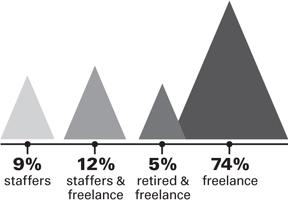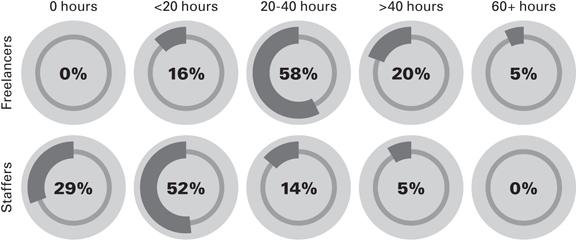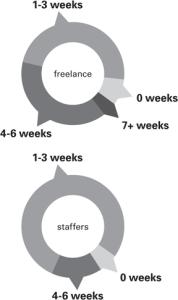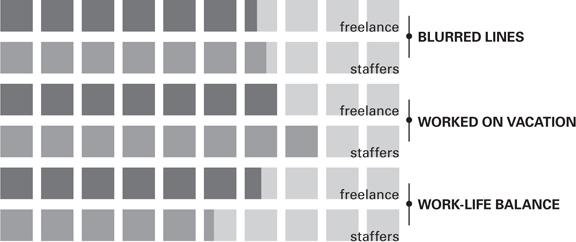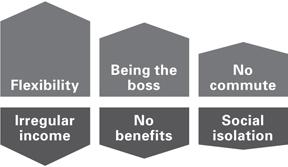Work-life balance survey from the Science Writers’ Handbook blog
By Hannah Hoag
Recently, our readers took a survey that asked science writers — both employed and freelance — about their work-life balance.
Career-related surveys often focus on how much money freelance science writers haul in — and that’s important information for understanding if freelancing is a sustainable career. But what about staffers? And what about everything else that goes with being a science writer?
We were curious to know how staffers and freelancers managed their work-life balance — each job style has rewards and drawbacks. How happy were people with their jobs? Were freelancers were any better off than staffers?Keep in mind that this survey is totally unscientific: Respondents are not representative of science writers at large, but those who read this blog and follow us on Twitter — and their friends. And we didn’t do any fancy statistics.
Instead, consider this to be a glimpse of life on the other side of the masthead.
Who answered the survey anyway?
Mostly freelancers, but we had a decent number of staffers too. In all, 128 started the survey and 96 finished it. On average, the respondents had 6 to 10 years of science writing experience.
But there were some outliers: Two staffers and eight freelancers had been working as science writers for more than 20 years, and one staffer and four freelancers had less than one year of experience.Just how many freelance hours are we putting in each week?
This is where things got a little more interesting on the work-life balance front — and started to challenge some of our assumptions.
Freelancers are working a pretty average work week. Although we didn’t ask for specifics on income, it’s interesting to note that freelancers aren’t piling in as many hours as they can to boost their income. Many of those who put in fewer hours considered themselves retired.Staffers are devoting a good number of their weekly hours to freelancing. Spoiler alert: Half of those staffers who aren’t freelancing worked weekends 50 to 100 percent of the time over the past 12 months.
Are we happy with our work-life balance?
Even when freelancers feel their work bleeds into their home life, it’s often because they want it to. They may work odd hours or on the weekends so they can hang out with their kids after school, operate a small farm, or exercise midday.
Freelancers are awfully good at taking vacations. Nearly 41 percent of freelancers take more than four weeks of vacation annually compared with 14 percent of staffers.Freelancers are also less likely to work during their vacations — and when they do, it’s often because they’ve managed to combine a story or a fellowship with the vacation to offset the costs.
Staffers, on the other hand, find themselves responding to their emails, updating social media, participating in meetings, and even doing edits and rewrites while their friends and families hang out at the beach.
On the whole, freelancers feel a little more balanced than staffers.
The best of the best and the worst of the worst
No surprises here, really. Freelancers love flexibility, being the boss, and avoiding long commutes. But they dislike irregular income, lack of benefits, and the social isolation that can come with freelancing. Some of the other perks? Comfy work clothes and naps!
When we asked about the best perk of working in an office or a co-working space, you said it was the chance to interact with colleagues. Freelancers take note: There are co-working spaces and office shares out there ready to release you from your isolation. (But they can’t help with the irregular income, sorry.)Big plans
Finally, we wondered how you were going to improve your work-life balance in 2014. Several of you said you weren’t going to change a thing: work was coming in, life was being enjoyed, and everything was hunkydory. But roughly 10 percent issued a call for help: You knew something had to change, but you weren’t sure where to start. Here are some ideas that came out of the survey.
Lead a more structured day and set limits
- Keep the work office for work only
- Create manageable to-do lists
- Don’t check emails in the evening or on weekends
- Wake up earlier so that mundane tasks can be tackled first
- Take more regular breaks
Break a sweat and be social
- Exercise during the workday
- Have lunch with friends during the week
- Plan visits to museums and other adventures
- Book more social activities to balance out the solitary work hours
Find better work and better paying work
- Shorten commutes by working at home more often or switching jobs
- Spend more time pitching for higher quality work
- Say ‘no’ to high-paying, but low-interest jobs
- Limit volunteering or other non-paying jobs
- Find a full-time job
“No one has it all: Work-life balance survey results,” the Science Writers’ Handbook blog, Nov. 13, 2013.
Hannah Hoag writes about science, medicine and the environment from her home in Toronto, Canada. Her work has appeared in newspapers and a wide range of magazines, including Nature, Wired, New Scientist, Reader’s Digest (Canada) and Canadian Geographic.
